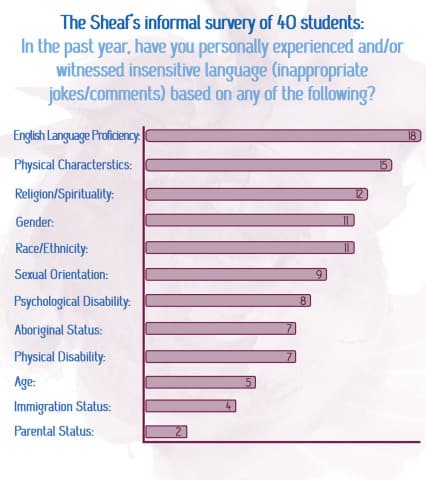SOMA DALI
University administrators took the temperature of student life on campus with the release of their results on the Campus Climate Survey on Nov. 17. Data for the comprehensive, 53 question-long survey which examined student belonging on campus, was collected in November of 2013 from 5,205 students.
“One of the strategic goals of the University of Saskatchewan, included in the third integrated plan, is to provide a safe and welcoming environment and to encourage and support activities that lead to the development of a more diverse and inclusive community,” wrote Patti McDougall, vice-provost of teaching and learning in an email interview with the Sheaf.
The survey included questions about harassment, discrimination and quality of support services. Many results gleaned from the survey appeared to be positive.
“I found lots of reason for optimism in the findings from the Campus Climate Survey,” wrote McDougall. “Beliefs about feeling comfortable and safe on campus were encouraging. I was very encouraged by what students reported on their classroom experiences. A very large majority said that they were treated fairly and felt comfortable. I also found it helpful to see that students provided strong endorsement of how helpful they find the services the university provides.”
Specifically, 79 per cent of respondents “felt comfortable or very comfortable at the U of S,” 85 per cent “saw themselves as being part of the campus community,” and 76 per cent “were satisfied or very satisfied with their academic experience at the U of S.” However, students who reported they had a mental health issue, a learning disability or were part of a sexual minority tended to rate the campus climate less positively.
When it came to campus support services, 81 per cent of international student respondents found the International Student and Study Abroad Centre (ISSAC) helpful or very helpful and 76 per cent of Aboriginal participants thought the same of the Aboriginal Students’ Centre. The Pride Centre was found to help 72 per cent of sexual minority participants while 66 per cent of respondents with disabilities found Disability Support Services helpful and 51 per cent of female respondents found the Women’s Centre helpful.
 However, in a statistic that may be troubling to some, out of the 21,027 students invited to participate in the survey only 25 per cent responded.
However, in a statistic that may be troubling to some, out of the 21,027 students invited to participate in the survey only 25 per cent responded.
“Interestingly, a response rate of 25 per cent is an indicator of a highly successful survey in a university student population,” McDougall said of the response rate. “It would be much more common to ask a population of more than 20,000 students to complete a comprehensive survey like this one and get answers back from less than 15 per cent. I was thrilled at the response rate.”
“More important than the number of students who responded were the individual characteristics of those who provided responses,” McDougall added. “In order to have some faith in the interpretation of these findings, it was very helpful to see that the characteristics of student participants mapped nicely onto the characteristics of our whole population of students.”
Of survey respondents, nine per cent identified as Aboriginal, 49 per cent belonged to the College of Arts and Science, 11 per cent of respondents were international students and eight per cent were parents, which McDougall said was an accurate representation of university demographics. McDougall also acknowledged that female students (which were 64 per cent of respondents) and graduate students (18 per cent) were slightly overrepresented.
In the additional comments section of the survey, one theme that emerged was the idea of unfair “special treatment” such as targeted scholarships, academic support and other advantages given to minority groups, particularly to Aboriginal students.
While McDougall did not support this view, and wrote that it was only expressed by a very small minority of participants, she wrote that engaging students in discussion about the unique social and cultural circumstances of Aboriginal people is an important task for university campuses, and offered a spirited defence of university policy.
“The data are very clear on the following point: Aboriginal people as a whole have yet to reach parity with the larger population in terms of educational attainment. To be fair does not always mean to treat everyone in the same way. So-called ‘special programs,’ whether academic, cultural or financial, are intended to work towards creating a fair university, where every student arriving here does have an equal opportunity to succeed,” McDougall said.
The next step for the Campus Climate Survey is for administrators to spend a few months, to a year, talking with students and staff to properly interpret the survey’s findings and to prioritize the steps that need to be taken to support those who are struggling.
The university will likely wait until 2016 to survey the student population again.
—
Graphic: Stephanie Mah/Graphics Editor